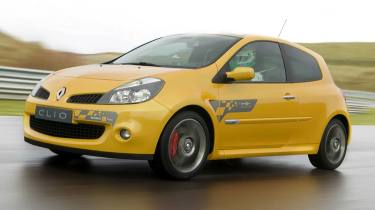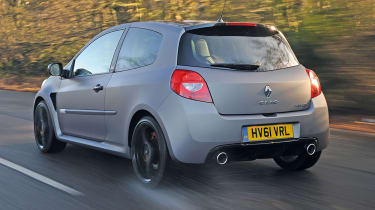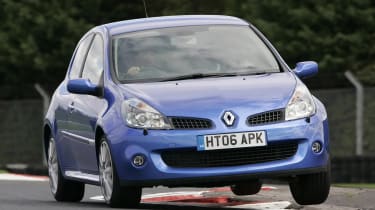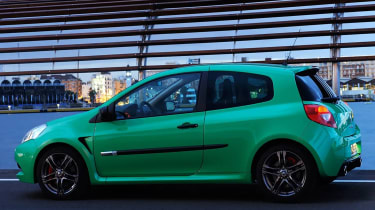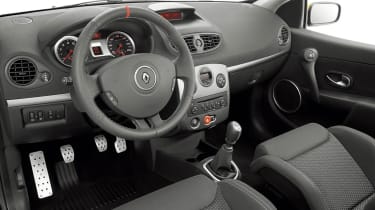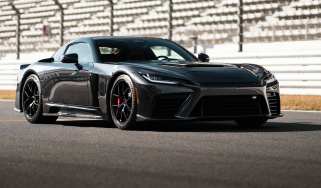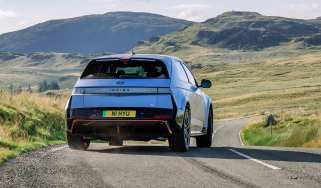Renault Sport Clio 197/200: history, specs and buying guide
Starting from just under £5000, a Renault Sport Clio is an extremely tempting used buy. We explain what to look for
The mid-2000s were awash with some absolutely legendary hot hatch icons, and the Renault Sport Clio was one of them. If there’s one thing the French know how to do, it’s make a fast, fun hot hatch, and a used Renault Sport Clio 197 from this golden era is still somewhat of a bargain. We’ll admit that when the 182 was replaced by the 197 in 2006 we felt a slight twinge of regret, because whilst the impressive new 197 was much more grown-up, with more weight and better build quality, some of its predecessor’s tactility had been lost, in part due to the electric steering.
However, even if a little of the fizz had gone, the 197 did benefit from a useful power increase – the two-litre naturally aspirated four-pot was now capable of 194bhp, albeit at a high 7250rpm. With a better driving position and cabin materials of a much better quality, the 197 felt much more refined than its predecessor, making the 182 suddenly look and feel very outdated. The 197’s eagerness and tendency for lift-off oversteer was certainly very amusing, and further developments eventually recaptured the missing zing of the 182…
More reviews
The 197’s generous specification at launch included four-piston Brembo front brake calipers with 305mm vented discs, a functional rear diffuser, air con, keyless entry and start, and 12-spoke 17-inch alloys with Continental SportContact tyres which were specific to the Clio. Five paint colours were available: two solid (Ultra Red and Racing Blue) and three metallic (Albi Blue, Deep Black and Nimbus Silver).
The sporty Clio line-up got much more interesting in 2007 when the F1 Team R27 special edition was released to celebrate Renault’s 2006 Formula 1 successes. An iconic Liquid Yellow paint colour was introduced with special side decals, as well as Recaro seats and a numbered plaque by the handbrake to commemorate the limited run. It also marked the first Cup chassis on a 197 model. It was 7mm lower with springs stiffened by 27 per cent up front and 30 per cent at the rear, with improved MacPherson struts to help sharpen the steering. The Cup package was soon offered as a £400 option on regular 197s, too. Cup chassis cars are distinguishable by their anthracite alloys and red calipers. These can easily be replicated, however, so the only sure-fire way of spotting one is to check the colour coding on the springs – orange and blue on the front and rear means it’s genuine.
At the same time, and slightly confusingly, Renault introduced the stripped-out, cut-price 197 Cup, which also featured the Cup chassis but did without steering wheel adjustment, air con, cruise control, key-card access, electric mirrors, and even the tool kit. It cost £1k less than a regular 197, though if you specced the manual air con and Recaros, it soon cost more.
Another useful improvement came in August 2008, with a new set of gear ratios, including a longer sixth that made for easier motorway cruising. Over the final few months of production, Renault offered a Lux model, which added a machined finish to the standard 12-spoke wheels, auto lights and wipers, climate control and leather upholstery.
Production of the 197 ended in summer 2009, when it was superseded by the Renault Sport Clio 200 – essentially the same car, but with a number of upgrades that finally allowed the third-generation Clio to reach its potential. The engine got minor changes to the head casting, variable valve timing and ECU map, lifting peak power to 197bhp, adding low- and mid-range muscle and dropping the 0-60 time from 6.9sec to 6.6.
The visible differences included a revised front bumper and headlights, five-split-spoke alloys and a revised rear diffuser, while the interior was given a general spruce-up and there were some tasty new options, including an integrated TomTom satnav and a panoramic sunroof.
Once again, the real interest lay under the skin, with new spring and damper rates on all versions and a quicker steering rack for the Cup variants, which this time were available right from the off. The 200 also adopted the torque-steer-killing ‘independent steering axis’ front suspension geometry first seen on the Mégane R26.R. The combined effect was stunning: more power everywhere, more steering feel and tight suspension control.
Three special editions to look out for are: the Gordini with its exclusive blue paint job, white stripes and unique alloy wheels with touches of blue (Cup pack optional); the Silverstone, in silver with a black roof and with the Cup pack, Speedlines and Recaros; and the Raider, in matt grey or red and with 18-inch R26.R wheels and leather Recaros.
Be aware that both the 197 and 200 like a drink, preferably the expensive stuff, ideally 99 RON. If driven gently, 30-33mpg is possible, but use all the performance regularly and you’ll see that drop to 25-28mpg.
All variants make fine trackday cars, though the standard brakes can quickly fade. Otherwise they seem to stand up well to track use, though always be extra attentive to the service history. As with any car, there are good and bad examples out there, but find the right one and you’ll have a blast.
I bought one - Tom Wigley
‘I bought my 200 with just 1200 miles on the clock, the previous owner having not got on with it. I’d owned bikes for a few years and at 23 thought it was time to calm down…
‘Love at first sight is maybe taking things too far, but having spotted a lovely Pearl White, black-roofed ‘full-fat’ [air con and cruise control] 200 round the back of Harratts Wakefield, I drove it away a week later.
‘Two years, 26,000 miles, six trackdays, one set of front discs, two sets of pads and at least three sets of tyres later, I find the car is very predictable and laps far faster on track than its price tag suggests; the brakes are like throwing an anchor out of the window.
‘It never missed a beat… until the gearbox started playing up. It’s a serious weak point on the car and all but admitted by Renault by them redesigning the synchros, though there’s been no recall yet. Luckily, Harratts replaced the ’box under warranty and it’s been fine since. I’m also now on my third set of Recaro seat covers and second steering wheel, all replaced under warranty.
‘There are faster cars and the Clio does lack torque, but if you ignore the 25mpg average fuel consumption, it’s a bargain.’
Buying checkpoints
Our guide here is William Moses of Clio197.net, and his first tip is to avoid cars with patchy history or missed services. The 12,000-mile/12-month service intervals are fine for cars used only on the road, but 6000 miles is preferable for cars that see track action. The cambelt service, due at 72,000 miles, is very important, should be undertaken on time and is an expensive job – £500 from an independent and over £800 from a Renault dealer.
Engine and gearbox
If correctly serviced, both engines are tough and reliable, although Moses advises avoiding cars with aftermarket induction systems. Also exercise caution with ‘performance’ exhausts; many reasonably priced systems have a reputation for exaggerating a flat-spot at moderate revs. Gearboxes are known to be awkward when cold, but all changes should be smooth when warm. Both versions of the gearbox are prone to premature synchro failure – generally most noticeable when changing down into third, especially if you skip a gear, though some owners have first noticed issues with fourth, so pay attention to the ease of the shift on the test drive.
Suspension, steering and brakes
Steering link rods seem prone to wear, though this is cheap to resolve. A clunking noise from the steering can indicate a failing rack; complete racks are not prohibitively expensive (£400-450 from Renault) and since they come complete with new track rods and track rod ends, it’s an opportunity to upgrade any 197 or non-Cup 200 to the slightly quicker Cup rack. Before doing so, make sure that this is the issue – there have been suggestions of failed power steering motors. These are part of the upper steering column and a replacement will cost close to £1000.
Body and interior
Both standard seats and Recaros are prone to wear on the outer bolsters. The top layer of the leather trim on the steering wheel can also peel off. Both can be retrimmed at around £50 per seat bolster, or £150 for a wheel retrimmed in Alcantara. The wiper mechanisms can be faulty, so check that the wipers operate freely, while you should also check that both key cards work – they cost £170 to replace.
What to pay?
Early 197s are now dipping below £4000 from private sellers. Generally these cars have higher miles (over 80,000) and more than one owner, but provided they’ve been well-maintained, they can still be a good buy. Take extra care to check the service history (including the cambelt), and pay particular attention to the gearchange and steering on a test drive.
Pay a little more, however, and from £7000 there’s a wide choice of average-mileage cars with Recaro seats and Speedline alloys. Cars with the Cup chassis start at around £5k. Expect to pay £8000-plus for a well-specced 2007/2008 car, and from £9k for the very best in terms of spec and condition. Reckon on adding around £500 if buying through the trade. Top price for an end-of-line 197 with Cup chassis is £9k – about the same as a cheap 200.
Specifications
| Engine | In-line 4-cyl, 1998cc |
| Power | 194bhp @ 7250rpm |
| Torque | 159lb ft @ 5550rpm |
| Weight (kerb) | 1240kg |
| Power-to-weight | 159bhp/ton |
| 0-60mph | 6.9sec (claimed) |
| Top speed | 134mph (claimed) |
| Price when new | £15,995 (2007) |
